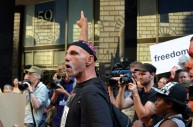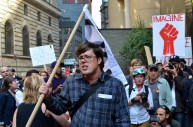After a weekend tune-up, Occupy Wall Street staged a major comeback yesterday in celebration of their one year anniversary. The city-wide protests resulted in Nearly 200 arrests yesterday, some after physical altercations with the police. Included in those arrested was Andrew Ross, a Social and Cultural Analysis professor at NYU and a longtime Occupy activist.
Despite professor Ross’ arrest, Carolyn Dinshaw, the chair of the Department of Social and Cultural Analysis, stood behind Ross and the Occupy Wall Street movement.
“Occupy Wall Street is a very important political movement,” Dinshaw said. “I personally support it, and I support Andrew Ross in his involvement
with OWS.”

The centerpeice of their demonstrations was a major rally in the Financial District yesterday to mark the roots of the sociopolitical movement against the top one percent of society’s abuse of power.
Protesters assembled at four different convergence points — Liberty Plaza, Ferry Terminal, 55 Water Street and the South Street Seaport — at 7 a.m. before convening at Bowling Green for the Storm Wall Street event three hours later.
Marching down to Wall Street, protesters echoed familiar chants that have become a staple of the Occupy movement.
“This is what a democracy looks like,” The protesters said while marching. “That is what a police state looks like.”
Throughout the morning and into the afternoon, three rows of New York City Police lined the main entry into Wall Street from Broadway, blocking it off so only those with IDs to prove their status of employment at the location could enter. Occupy march lines started from Zuccotti Park and avoided those barriers, often being rerouted and forced back by police.

Dinshaw’s view of the significance of the movement was echoed by Social and Cultural Analysis professor Lisa Duggan, who taught a course on OWS last year.
“I do think OWS brought a whole range of critical, social and economic issues to the front of public consciousness. Foreclosure, student debt, inequality in general and the groupings in many localities also participated in ongoing actions, like the protests against stop-and-frisk in NYC,” she said.
While the movement drew national headlines a year ago, the number of organized rallies had diminished in recent months.
But Joan Livingston, a protester from Boston who came to join the New York demonstrations, rejected the notion that the movement was dissolving.

“The one thing I would want people to know is that, contrary to what they might be hearing from big media, the occupy movement is still very much alive,” Livingston said. “There are still a lot of people working every day to make this world a better place and we think it is far from over and we wonder why aren’t people telling that story?”
Other occupiers agreed, claiming the movement is live and well.
“We never left, we never went away,and we’re never going to go away,” said Jennifer Maskell, New Yorker, who has been with OWS since its first week.
Gallatin junior Caitlin McLaren said the movement has made many accomplishments in the past year.
“I’m excited by all the groups that came out of the movement and all the connections that people have made with each other,” McLaren said.

A version of this article appeared in the Tuesday, Sept. 18 print edition. Additional reporting by Andrew Karpan, Jake Priley, Tricia Lin, Matt Steinberg and Daniel Huang. Tony Chau is city/state editor. Email them at [email protected].






















































































































































